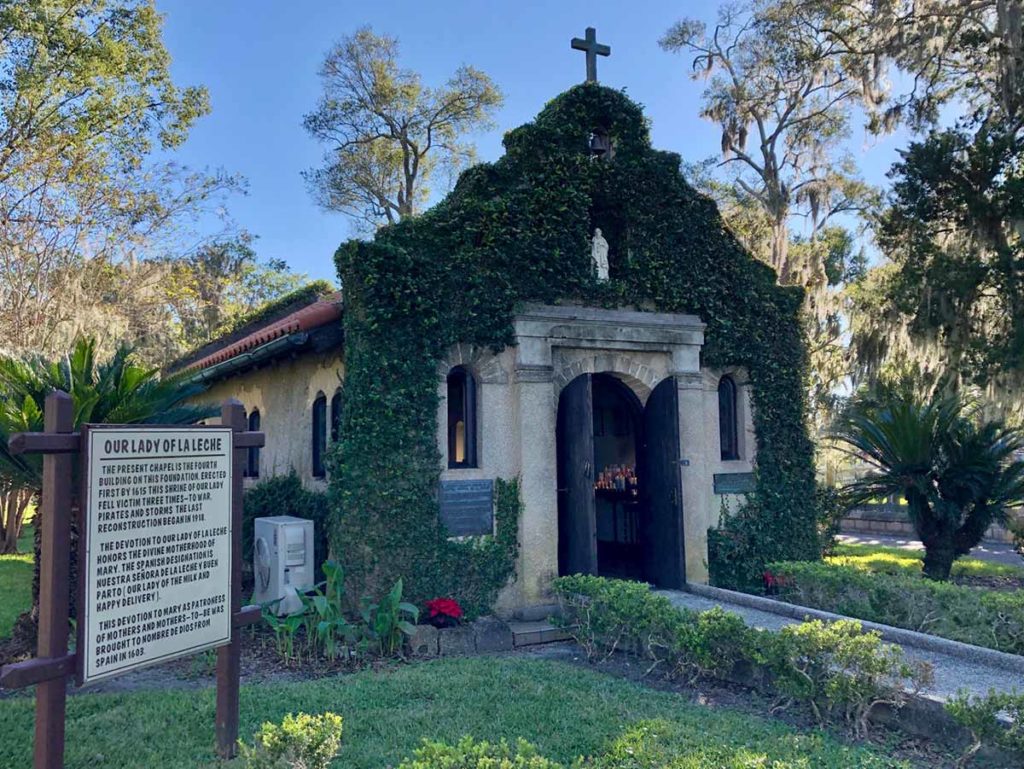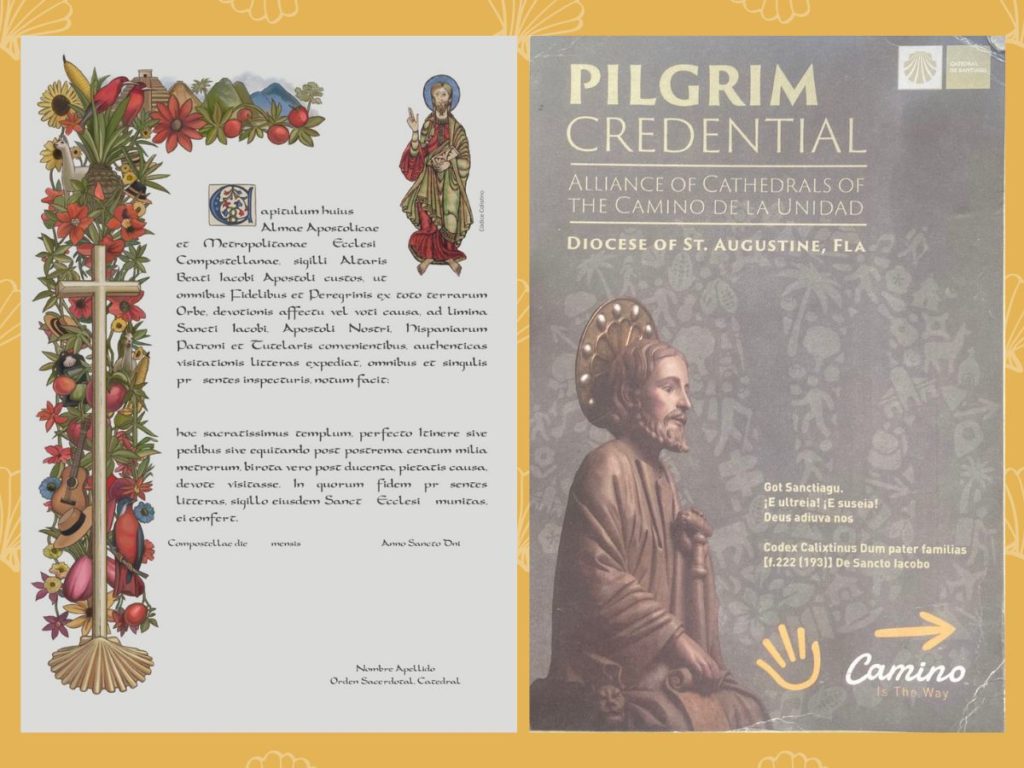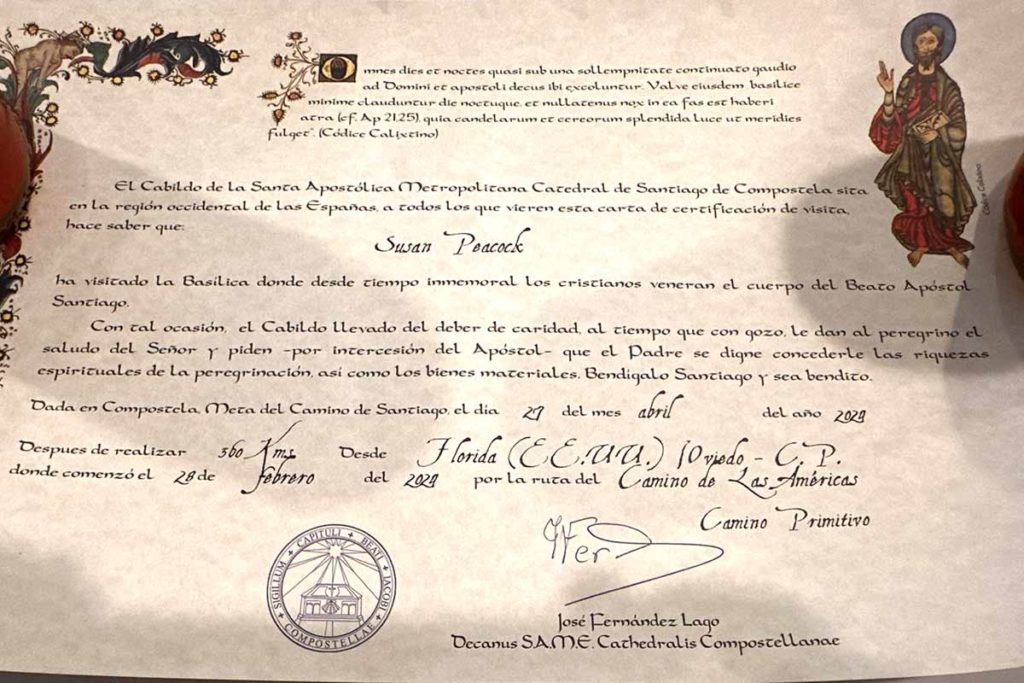Camino de las Américas: Start Your Camino de Santiago in St. Augustine, FL


Camino de las Américas: Start Your Camino de Santiago in St. Augustine, FL
by Susan Peacock | Jacksonville, FL
I completed my 11th Camino in April 2024. What made that pilgrimage especially notable—besides it being my first time on the Primitivo route and that I walked it with friends from North Carolina and Australia who I had met in 2023 on the Camino Francés—is that my first steps of this journey began on the Camino de las Américas from Jacksonville Beach to St. Augustine, FL.
You read that correctly! You can officially start the Camino de Santiago in Florida. For those who walk the Camino de las Américas and obtain a transitory certificate documenting their completion of that pilgrim route, the Oficina de Acogida al Peregrino, or Pilgrim Reception Office, in Santiago de Compostela, will recognize 30 kilometers toward the minimum 100 kilometers a pilgrim must walk to qualify for a Compostela upon arrival in Santiago de Compostela.
Camino de las Américas History
When the Cathedral Basilica of St. Augustine joined the Alliance of Cathedrals in 2022, the alliance designated this cathedral in northeast Florida as the official starting point in the U.S. for the Camino de Santiago (see an earlier article about this in La Concha Autumn 2022, page 6). The alliance includes cathedrals situated along various Camino routes in Spain—including cathedrals in Córdoba, Madrid, Alcalá de Henares, Avilés, Oviedo and Santiago de Compostela—as well as in the Americas—including the Catedral del Cusco in Peru and the Cathedral Basilica of St. Augustine. The purpose of the alliance is to promote greater spirituality and intercultural understanding.
St. Augustine is recognized as an official starting point for the Camino in the United States and the terminus for a network of planned routes initially referred to as the Camino de Mestizaje, and then the Camino de la Unidad, and now the Camino de las Américas. The Camino de las Américas is a recognized extension of the Camino de Santiago in the Americas, and will eventually connect historical pilgrimage and trade routes across North, Central, and South Americas.
The Camino de las Américas is the brainchild of Francisco Guitard, founder and executive director of Instituto NAUTA, started in Málaga, Spain, and now in St. Augustine. The institute’s aim is to strengthen fraternal ties among countries of Spanish tradition and culture. Guitard walked his first Camino de Santiago in 1999 with a school group, sparking a lifelong passion. He has envisioned a route connecting the Old and New Worlds, inspiring others to discover not only the history and spirituality of the Camino de Santiago but also the profound sense of unity it fosters. Guitard says he hopes the Camino de las Américas “will inspire people across the Americas to take their first steps, to connect with their roots, and to discover the joy of being part of a living tradition that continues to evolve.”
Established & Planned Routes
The first established U.S. route of the Camino de las Américas follows the First Coast Route, which connects Jacksonville Beach in northern Florida to historic St. Augustine. Other Florida routes are in the works, including one linking Miami near the state’s southern tip to St. Augustine, and another continuing west from St. Augustine to Tallahassee.
The plan eventually is to extend the U.S. portion of the Camino de las Américas with a route beginning in San Diego, CA, and traversing the United States along historical paths such as the mission trails in California and Texas and paths rooted in ancient indigenous trade. (Read about several American Pilgrims chapters who recently coordinated a group walk on the San Antonio Missions Trail here.)
Plans for the Camino de las Américas extend far beyond the United States. The network eventually aims to follow ancestral pathways such as the Inca Trail in South America and the Camino Real de Tierra Adentro in Mexico, to name just two. Understandably, establishing and connecting this extensive network will take years if not decades and will require the help of volunteers to scout and establish the routes.

How to Walk the Camino de las Américas
As experienced Camino pilgrims might imagine, a route along the beach in Florida does not resemble walking the Camino in Spain. There are no yellow arrows guiding the way, no albergues for pilgrim lodging, and sellos to document your progress are not available at all required stops. So how do you walk this route?
One option is to take part in Baby Steps Camino, coordinated each December by the Order of Malta, a lay religious order of the Catholic Church. Pilgrims walk 30 miles (50 kilometers) over three days from Jacksonville Beach to St. Augustine on the First Coast Route of the Camino de las Américas, with the Order of Malta arranging logistics for registered participants. Along with walking, the program includes daily mass and pilgrim socials. Since starting in 2017, Baby Steps Camino has grown in popularity with hundreds of people walking and registration filling quickly.
If you wish to walk the First Coast Route of the Camino de las Américas at another time, you will need to sort the logistics yourself. Following is information to help you plan:
- Accommodations: Arrange your accommodations at a hotel or through a vacation rental service.
- Transportation: Use a car drop or rideshare service or check local public transit options to get to/from the beginning/end of each day’s walk. Public parking options make it possible to break the route into approximately 5-mile sections.
- Trail surfaces: The first 10 miles starting at Jacksonville Beach Pier are relatively easy walking on hard packed sand. The next 15 miles are more difficult walking on soft sand and an often sloped beach. Consider the tide schedule, as it is difficult to walk at high tide. The final section is on pavement, crossing a bridge to arrive in St. Augustine, with a stop at the National Shrine of Our Lady of La Leche before arriving at the Cathedral Basilica of St. Augustine.
- Credential: A credential is required to begin your journey on the Camino de las Américas and continue on a Camino de Santiago route in Spain. The credential is currently available for purchase ($10) at the National Shrine of Our Lady of La Leche gift shop just north of downtown St. Augustine and the Cathedral Basilica of St. Augustine gift shop in the historic downtown, and at the First Coast Cultural Center in Ponte Vedra Beach (inland of Hwy. A1A; not easily accessible on foot from/to the beach). Visit their websites for current hours of operation.
- Digital App: Download the Camino Is The Way app (available for Android and iOS). Along with route information and GPS tracking, the app allows you to collect digital stamps at the six significant stops along the route (see below) as physical stamps are not currently available at all stops. The digital stamp you collect in your app at each stop serves as proof of your distance walked to receive the physical stamps in your credential and obtain the transitory certificate (see below).
Tip: Make sure location services for this app are turned on; if not, digital stamps may not properly record in the app. As a backup measure, take a photo to document your stop at each significant location.

- Six Significant Stops: There are six significant stops required to document your Camino de las Américas First Coast Route journey and qualify for a transitory certificate (certificate of completion.)
These stops are:- St. Paul’s Catholic Church (Jacksonville Beach)
- Our Lady Star of the Sea Catholic Church (Ponte Vedra Beach; collect digital stamp at The Lodge & Club; church isn’t on the beach but slightly inland and parallel to the lodge)
- Mickler’s Landing Beachfront Park (Ponte Vedra Beach)
- Guana Tolomato Matanzas National Estuarine Research Reserve (Ponte Vedra Beach)
- National Shrine of Our Lady of La Leche (St. Augustine)
- Cathedral Basilica of St. Augustine (collect digital stamp at gift shop or west courtyard booth).
- Physical Stamps & Transitory Certificate: Once you have walked to and documented your stops at all six significant locations, return to the National Shrine of Our Lady of La Leche gift shop to show your digital app stamps, obtain physical stamps in your credential, and receive your Camino de las Américas transitory certification (certificate of completion).
Tip: If you intend for your Camino de las Américas to count toward Compostela requirements for the Camino de Santiago, you will need to document two stamps per day/section and obtain the transitory certificate. If you break any section of the Camino de las Américas into multiple days, be sure to get a stamp for each day’s ending point, and another stamp the next day showing you resumed from that same point. - Compostela: Documented completion of the Camino de las Américas qualifies you for 30 kilometers credit toward the required minimum 100 kilometers walked to obtain a Compostela. You must then walk at least 70 kilometers (obtaining at least two sellos in your credential per day) on a recognized Camino route in Spain and walk the final stage into Santiago to qualify for a Compostela. Present your credential with all required stamps and your Camino de las Américas transitory certificate at the Pilgrim Reception Office in Santiago to request your Compostela. If you request a distance certificate, your documented distance along the Camino de las Américas will be included in your total distance.
Tip: Do not use the completion stamp space at the bottom of the credential’s first page; this space is reserved for the Pilgrim Reception Office to document your arrival in Camino de Santiago in order to issue the Compostela.


If you’re keen to explore Camino routes throughout the world, check out our routes page.


